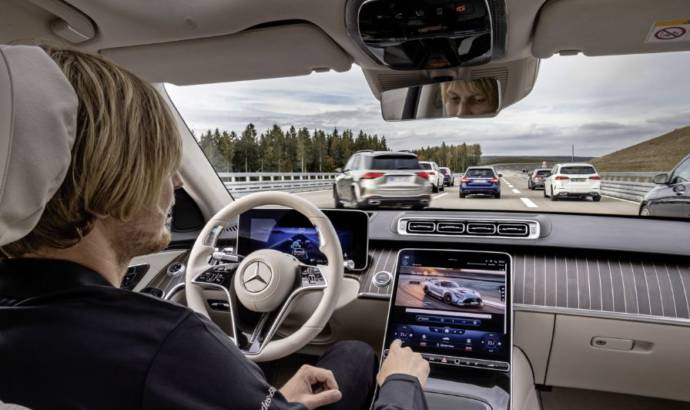Want to drive an autonomous car in Europe starting next year? You might be surprised to find out that Mercedes-Benz will offer you that car. Not Tesla.
Mercedes-Benz is the first automotive company in the world to meet the demanding legal requirements of UN-R157 for a Level 3 system. The German Federal Motor Transport Authority (KBA) has granted system approval for this on the basis of the technical approval regulation UN-R157, thus paving the way for offering such a system internationally, provided that national legislation allows it.
Germany has taken a pioneering role in this with the opening of the Road Traffic Act (StVG) for Level 3 systems in 2017. As a result, the first customers will be able to buy an S-Class with DRIVE PILOT the first half of 2022, enabling them to drive in conditionally automated mode at speeds of up to 60 km/h (37 mph) in heavy traffic or congested situations on suitable stretches of highway in Germany.
The special DRIVE PILOT equipment takes the strain off the driver and allows them to perform ancillary tasks on the central display such as online shopping or sending e-mails in their in-car office. The system approval also applies to the EQS.
The technical approval regulation with which such a system can be certified did not come into force until the beginning of 2021. Since then, it can be implemented in Europe – an opportunity that Mercedes-Benz was quick and the first manufacturer to seize. With the opening of the Road Traffic Act (StVG) for Level 3 systems in 2017, Germany was the first country to create a legal basis for the intended use of these systems.
Mercedes-Benz is initially offering DRIVE PILOT on 8,197 miles of highway in Germany. Extensive test drives for this systems are already underway, for example in the USA and China. As soon as there is a national legal framework for conditionally automated operation in additional markets, the technology will be rolled out step by step.
On suitable highway sections and where traffic density is high, DRIVE PILOT can offer to take over the driving, initially up to the legally permitted speed of 37 mph. The controls needed for this are located in the steering wheel rim, on the left and right above the thumb recesses. When the driver activates DRIVE PILOT, the system controls the speed and distance, and effortlessly guides the vehicle within its lane. The route profile, events occurring on the route and traffic signs are correspondingly taken into consideration. The system also reacts to unexpected traffic situations and handles them independently, i.e. by evasive maneuvers within the lane or by braking maneuvers.
DRIVE PILOT builds on the surround sensors of the Driving Assistance Package and comprises additional sensors that Mercedes-Benz considers indispensable for safe conditionally automated driving. These include LiDAR, as well as a camera in the rear window and microphones, particularly for detecting blue lights and other signals from emergency vehicles, as well as a moisture sensor in the wheel well. In addition to the sensor data, the DRIVE PILOT receives information about the road geometry, route profile, traffic signs and unusual traffic events (i.e. accidents or roadworks) from a digital HD map. This is made available and updated via a backend connection. The S-Class with the optional DRIVE PILOT also has supplemental steering and braking systems and a supplemental on-board electrical system, so that it remains maneuverable even if one of these systems fails and the safe handover to the driver can be ensured.
If the driver fails to take back control even after increasingly urgent prompting and expiry of the takeover time, i.e. due to a severe health problem, the system brakes the vehicle to a standstill in a controlled manner and with suitable deceleration. At the same time the hazard warning lights and, once the vehicle has come to a standstill, the Mercedes-Benz emergency call system is activated and the doors and windows are unlocked, to make access to the interior easier for any first responders.



